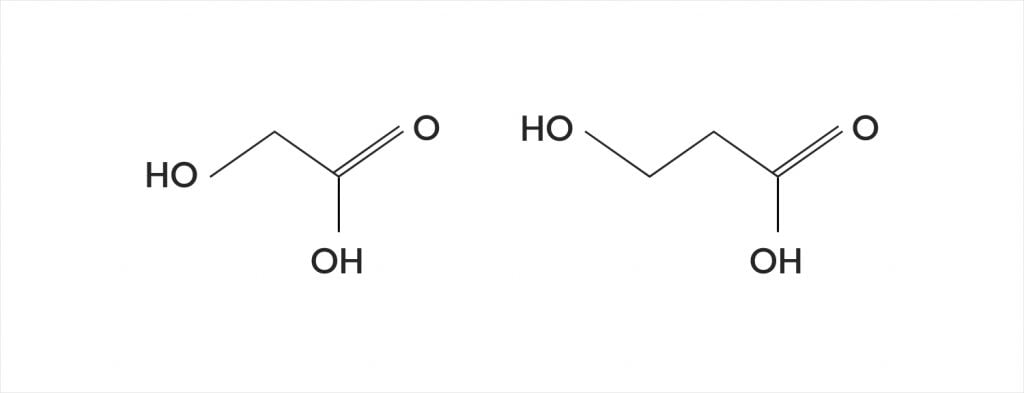Exfoliation is the key to a radiant complexion. In fact, many dermatologists believe it’s the most essential part of a skincare routine. If you’re not already exfoliating, you should make an effort to start right away — especially if you’re looking for a smoother texture, less acne, fewer wrinkles, and more radiance. Honestly, who couldn’t get on board with that?

If you’re confused about the different types of chemical exfoliants out there, particularly when it comes to alpha hydroxy acids (AHAs) and beta hydroxy acids (BHAs), you’re not alone. With that said, let’s break down AHA VS BHA, including their copious benefits.
The Difference Between AHAs and BHAs
Alpha hydroxy acids and beta hydroxy acids have a lot in common. Both work as exfoliants to help unclog pores (by “ungluing” the sebum (oil) and bonds that hold skin cells together) and slough away dead skin cells to promote smoother, more radiant skin.
They can both:
- Smooth and soften rough texture
- Reduce the appearance of fine lines and wrinkles
- Provide hydration
- Brighten and even out skin tone
- Unclog pores
The main difference between AHAs and BHAs is that they are water-soluble and oil-soluble, respectively. One is not necessarily better than the other — it all depends on what you’re looking for in terms of treatment.
AHAs are mainly used for:
- Fading away hyperpigmentation
- Reducing surface wrinkles
- Increasing collagen production
- Thoroughly exfoliate
- Provide antioxidant protection (depending on the AHA)
An AHA exfoliant is typically used for anti-aging benefits, even though they can effectively treat acne as well. AHAs are recommended for normal to dry skin types because they have a greater moisturizing ability than BHAs.
Alpha hydroxy acids include water-soluble acids like glycolic, citric, and lactic acids. Though “acid” can be an intimidating term, these kinds are safe to use on the skin to help unclog pores, fight acne, restore radiance, fade away dark spots and acne scars to even out skin tone and improve overall texture. Since AHAs are water-soluble, they tend to work more on the surface of the skin. This is also why they are recommended for dry to normal skin types.
BHAs are mainly used for:
- Fighting acne
- Reducing inflammation
- Improve skin tone and texture
BHAs are oil-soluble and work deeper inside the pore to remove sebum and dead skin cells (they penetrate deeper into the pore than alpha hydroxy acids). They are recommended for combination to oily skin that is prone to acne and enlarged pores.
Beta hydroxy acids include salicylic acid, which is commonly found in many anti-acne products. Sometimes citric acid can also be classified as a BHA, though it is less common. Moreover, unlike alpha hydroxy acids, beta hydroxy acids can reduce inflammation and calm red, irritated skin. This is an ideal ingredient to be used for sensitive skin or rosacea because it is relatively gentle overall.
AHA and BHA Together
If you happen to have acne and signs of aging, you can alternate between AHAs and BHAs for the best results. Layering them on top of one another may occasionally lead to irritation if not used correctly.
However, some skincare products are specifically formulated with both AHAs and BHAs for a potent combination that is nonetheless not irritating. If you’re looking for a great chemical exfoliant, you can try Formulyst’s Retexturing and Perfecting Serum. This liquid AHA serum was specially formulated with an AHA/BHA plant extract complex to gently but efficiently remove dead skin cells for a more refined complexion.

The Details On The Different AHAs and BHAs
Glycolic Acid (AHA)
Glycolic acid is typically derived from sugar cane. It has the smallest molecular size of all the acids (meaning it can efficiently penetrate the skin). It has a reputation for being one of the best anti-aging ingredients on the market.
Chemical peels administered at dermatologist’s offices usually feature glycolic acid.
It works by basically removing the “glue” that holds skin cells together. This “glue” is essentially built-up sebum (oil) and other lipids that clump dead skin cells together and cause clogging. By removing these dead skin cells, glycolic acid helps the products you’ll layer on afterward penetrate better. On top of that, glycolic acid has been shown to stimulate collagen production.
In dermatologists’ offices, glycolic acid peels are administered in concentrations as high as 70 percent. In over-the-counter products, you can expect to find concentrations between eight and 30 percent. Thirty percent is considered relatively high but still safe to use. However, it can be rather irritating.
Sensitive skin types and those with rosacea are typically advised not to use glycolic acid. Moreover, it’s best to avoid sun exposure and be generous with sunscreen if you use glycolic acid regularly. Glycolic acid can dry out the skin, so follow up with a moisturizer to counteract this. Finally, you should note that it’s okay if you feel a tingling sensation when you use glycolic acid products, but if you’re feeling a burning sensation rather than a tingling, you should stop using the product.
Citric Acid (AHA)
Citric acid is naturally found in citrus fruits. It’s mainly used to adjust the pH in certain products to keep them from being too alkaline. While it’s not as well studied or nearly as popular as glycolic acid, it can be combined with glycolic acid and other acids to promote a deeper exfoliation. Like glycolic acid, it also works by removing the binding between dead skin cells to help to loosen them.
Citric acid can help fade discoloration to even out skin tone, treat blemishes, unclog pores, and soften fine lines. Deeper wrinkles, however, would need more serious treatment like injections or laser treatment.
Citric acid is also used to lighten the skin (thanks to its vitamin C content) and work as an astringent. It can cause mild side effects like redness and peeling and has a tingling sensation when applied.
Lactic Acid (AHA)
Lactic acid is naturally found in milk. It’s a popular skincare ingredient in exfoliating masks, lotions, creams, toners, and cleansers. It dissolves dead skin cells to reveal brighter, more radiant skin. Like the preceding acids, it can also positively affect acne, discoloration, texture, dullness, and fine lines.
Unlike glycolic acid, it’s more moisturizing and therefore less irritating for those with sensitive skin. However, higher concentrations of this acid can still be irritating. If you’re unsure if it’s right for you, do a patch test on the inside of your arm first.
Other
Other AHAs include mandelic acid (made from almond extracts), malic acid (made from apple acids), and tartaric acid (derived from grape extracts). These are less well-known but can improve the effectiveness of the more powerful, better-known acids when combined with them.
Salicylic Acid (BHA)
SA is commonly used in over-the-counter acne products, typically at concentrations between 0.5 and 5 percent, though 2 percent is average. Salicylic acid is oil-soluble, making it perfect for oily and combination skin. It works on the skin’s surface to exfoliate but also moves deeper into the pore to break up sebum. In addition to helping unclog pores and fight acne, salicylic acid can help calm redness and inflammation.
Betaine salicylate (BHA)
Derived from sugar beets, this BHA is a gentle alternative to salicylic acid, and according to this study, it is equally effective. Approximately 4% betaine salicylate is considered to be the equivalent of 2% salicylic acid.
Salix Alba (Willow Bark Extract; BHA)
A natural BHA, its salicin content converts into salicylic acid, though it’s a lot weaker than traditional SA.
AHA and BHA Exfoliants: The Final Word
Exfoliation is the key to a radiant complexion. In fact, many dermatologists believe it’s the most essential part of a skincare routine. Alpha hydroxy acids and beta hydroxy acids have a lot in common. Both work as exfoliants to help unclog pores (by “ungluing” the sebum (oil) and bonds that hold skin cells together) and slough away dead skin cells to promote smoother, more radiant skin.
An AHA exfoliant is typically used for anti-aging benefits, even though they can effectively treat acne as well. AHAs are recommended for normal to dry skin types because they have a greater moisturizing ability than BHAs. Alpha hydroxy acids include water-soluble acids like glycolic, citric, and lactic acids. Since AHAs are water-soluble, they tend to work more on the surface of the skin. This is also why they are recommended for dry to normal skin types.
BHAs are oil-soluble and work deeper inside the pore to remove sebum and dead skin cells (they penetrate deeper into the pore than alpha hydroxy acids). They are recommended for combination to oily skin that is prone to acne and enlarged pores.
Beta hydroxy acids include salicylic acid, which is commonly found in many anti-acne products. Sometimes citric acid can also be classified as a BHA, though it is less common. Moreover, unlike alpha hydroxy acids, beta hydroxy acids can reduce inflammation and calm red, irritated skin. This is an ideal ingredient for sensitive skin or rosacea because it is rather gentle overall.
Alpha and beta hydroxy acids are an effective addition to your skincare routine, but the trick is finding the right one. Check out our guides to the best chemical exfoliants and best at-home chemical peels to help you determine the best formula for you.
References:
Clinical, Cosmetic and Investigational Dermatology, “Glycolic Acid Peel Therapy – A Current Review”; Clinical, Cosmetic and Investigational Dermatology, “Salicylic Acid As A Peeling Agent: A Comprehensive Review.”







